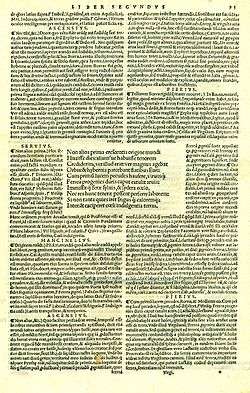Jodocus Badius


Jodocus Badius (French: Josse Bade; Spanish: Jodoco del Badia; 1462–1535), also known as Josse Badius, Jodocus van Asche Badius, and Badius Ascensius,[1] was a pioneer of the printing industry, a renowned grammarian, and a pedagogue.
Life
Josse Badius was born in the village of Asse (formerly Assche) near Brussels in Flemish Brabant in AD 1462.[1] He was a scholar of considerable repute, studying in Brussels and Ferrara and teaching Greek for several years at Lyon, France.[1] During the years 1492–1498, while in Lyon, he began working as a proofreader and editor for the printer Jean Trechsel.
He moved to Paris, where he established his own printing house in the year 1503. This eventually took the name Prelum Ascensianum.[1] With 775 editions,[2] it served as one of the most active publishers during the first three decades of the 16th century. He specialized in Roman classical texts in Latin, often with his own familiare commentum for the student market. For example, for the 2nd-century BC Roman playwright Terence, Badius printed a Praenotamenta in 1502.[3] This introduced the subject of Roman comedy through a lengthy treatment of general theories of poetry and thorough discussion of its origins, development, and classifications. He also published work by contemporary humanist writers.[2] He frequently worked with or for Johannes Parvus (Jean Petit), the era's most important bookseller and publisher.
He was also the author of numerous pieces, amongst which are a life of Thomas a Kempis and a satire on the follies of women entitled Navicula Stultarum Mulierum.[1]
Badius died in 1535.[1] His work was continued by his 2nd son Conrad. His epitaph was written by his grandson Henry Stephanus.[1] Conrad confessed to being a Huguenot and forced to flee to Calvinist Geneva in 1549.
Gallery
-

Monogram I V A B (Iodocus Van Asche Badius) on the lower part in a woodcut from 1508.
-

Prelum Ascensianum in 1508, after a woodcut by Badius[1]
- ^ Smith (1904), p. 72.
See also
References
Citations
Bibliography
- Badius, Jodocus (1502), White, Paul, ed., Praenotamenta to the Commedies of Terence.
- "Jodocus Badius", Encyclopædia Britannica, 9th ed., Vol. III, New York: Charles Scribner's Sons, 1878, p. 228.
- "Jodocus Badius", Encyclopædia Britannica, 11th ed., Vol. III, Cambridge: Cambridge University Press, 1911, p. 189.
- Smith, A.M. (1904), Printing and Writing Materials, Philadelphia.
- Renouard, Philippe (1969), Imprimeurs & Libraires Parisiens du XVIe Siècle, Vol. II, Paris. (French)